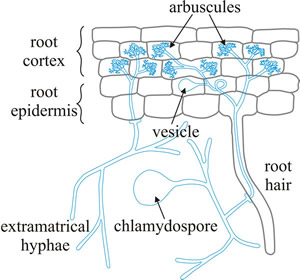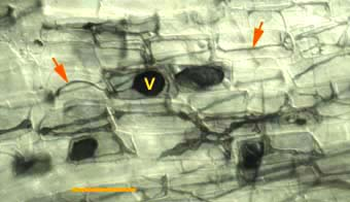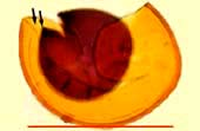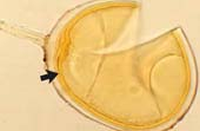Arbuscular mycorrhizasArbuscular (AM) endomycorrhizas are the most common type of mycorrhizal association, and were probably the first to evolve; the fungi are members of the Glomeromycota. In other textbooks you may find these fungi placed in the Order Glomales and Phylum Zygomycota but this is incorrect. The AM fungi are obligate biotrophs, and they are associated with roots of about 80% of plant species (that’s equivalent to about two-thirds of all land plants, or around 90% of all vascular plants), including many crop plants. The AM association is endotrophic, and has previously been referred to as a vesicular-arbuscular mycorrhiza (VAM). This name has since been dropped in favour of AM, since members of the Family Gigasporaceae do not form vesicles. Fig. 1 illustrates the main features of this type of mycorrhiza.
There is a wide-ranging fungal mycelium within the host root, and AM fungi explore the soil or other substrata with an extensive extraradical mycelium. Externally to the host the fungal hyphae produce the very large spores (often called chlamydospores). Formation of the mycorrhizal association is an infection process. Spores germinate near a plant root and the germinating hyphae penetrate the root in response to root exudates. Hyphae grow through the root tissues and in the root cortex hyphal branches form appressoria that penetrate the plant cells. The host plasmalemma invaginates and proliferates around the fungal intrusion. Repeated dichotomous branching of the fungal ‘hypha’ produces the arbuscule (Fig. 2) inside the cortical cell. Arbuscules have a lifespan of 4-15 days, after which they break down, and the plant cell returns to normal.
Hyphae are shown in the diagram above (Fig. 1) and in the photomicrograph in Fig. 2. Hyphae can grow between root cortical cells and also penetrate individual cells, forming arbuscles (Fig. 2). These are finely branched clusters of hyphae, which are thought to be the major site of nutrient exchange between fungus and plant. The large surface area of the arbuscles is ideal for the fungus to receive carbohydrates from the plant and for the plant to obtain mineral nutrients that the hyphae have scavenged from the soil. AM fungi may also produce vesicles inter- or intracellularly within the roots. These are swollen spherical or oval structures (Fig. 3) containing lipids, which are thought to be used for storage.
Spores (Fig. 4), are formed on the external mycelium. Examination of spores is often used to identify the particular genera and species of an AM fungus because of the lack of other morphological features.
AM fungi are distantly related to other Zygomycetes and are now placed in phylum Glomeromycota. This suggests that AM fungi diverged and became specialised to their mycorrhizal association long ago. Current estimates place the origin of AM-like fungi at 353-462 million years ago (at least). This date also coincides with the colonisation of land by plants, and there is fossil evidence to suggest that AM-like associations were instrumental in this colonisation. Click to read more about the evolution of mycorrhizas. Within the extant members of the AM fungi, 6 genera are identified: Acaulospora, Entrophospora, Gigaspora, Glomus, Sclerocystis and Scutellospora. Gigaspora does not form vesicles. Between 150 and 200 species are currently known, and yet this small number accounts for associations with over two-thirds of all plant species. The taxonomy is still largely based on characteristics of the relatively large (40 to 800 µm diameter) multinucleate spores that are formed on the mycelium external to the host root. Studies using molecular markers have revealed a great deal of diversity suggesting that the number of 200 or so described morphospecies might be an underestimate of the true diversity of the phylum. All AM fungi are obligately biotrophic, as they are completely dependent on plants for their survival. This is not usually a problem for AM fungi, as they show little or no host specificity. AM fungi are not restricted to any particular taxonomic group (unlike ericoid and orchid mycorrhizas) and are found extensively in pteridophytes, gymnosperms and angiosperms of all habitats. Since AM fungi are obligately biotrophic, attempts to grow them on their own in culture have so far failed. However, since the majority of commercially grown plants form AM associations, interest in developing ways of inoculating crops with the best fungus continues to intensify. Click for more details on the commercial applications of mycorrhizas. |
||||||||||||
To skip to other mycorrhizal types, click below: |
|||
Close the window to return to your previous page |
|||




